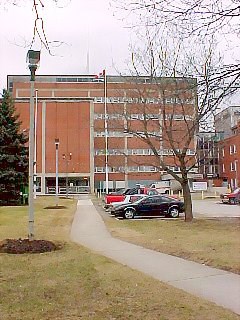NEWS RELEASES
OFFICE OF THE CHIEF CORONER
SAULT AREA HOSPITAL
************************* Office of the Chief Coroner announces conclusions and recommendations from investigation into C. Difficile deaths TORONTO, May 9 - Dr. Bonita Porter, Deputy Chief Coroner of Inquests, today announced that conclusions and recommendations have been made as a result of the investigation into 26 deaths which occurred at the Sault Area Hospital between April and November 2006 where Clostridium difficile (C. difficile) bacteria was thought to be a factor.
The Office of the Chief Coroner established an expert review committee to examine each of the cases in Sault Ste. Marie where C. difficile was suspected of contributing to the death.
Of the 26 cases reviewed, it was determined that C. difficile caused 10 of the deaths and was a contributing factor in another eight.
C. difficile was not a factor in the remaining eight deaths. As a result of the examination by the Expert Review Committee and further investigation by the Office of the Chief Coroner, it has been concluded that:
- The Sault Area Hospital became aware of an outbreak of C. difficile in October 2006 when the infection control practitioner was speaking with a consultant regarding an increasing number of infections and the report of a confirmed case of the Quebec Strain of the disease.
- The 26 cases reviewed by the panel included all deaths that occurred between April 1, 2006, and November 30, 2006, where a diagnosis of C. difficile had been made.
- Documentation on the patient record by physicians, nurses and the Infection Control Practitioner about the reporting of cases and recording of isolation techniques was minimal or absent.
- Policies and procedures for management of outbreaks are in place at the Sault Area Hospital.
- Hospital overcrowding - with occupancy rates over 100 per cent, combined with an older, limited physical plant - may have played a role in propagating the C. difficile outbreak as there were limited opportunities to individually isolate C. difficile infected patients.
- The widespread use of antibiotics was likely one of the contributing factors to the development of the C. difficile outbreak.
In order to prevent the likelihood of further C. difficile outbreaks, the following recommendations are being distributed to hospitals and long-term care facilities, the Ontario College of Physicians and Surgeons, the Ontario Hospital Association, the Ontario Medical Association, the College of Pharmacists of Ontario and the Ontario Nursing Association:
- All hospitals and health-care facilities in Ontario are reminded to be familiar with the Ministry of Health and Long-Term Care Provincial Infectious Diseases Advisory Committee's "Best Practices Document for the Management of Clostridium difficile in all Health-Care Settings."
- Health-care facilities should establish a surveillance mechanism that facilitates identification and tracking of confirmed cases of C. difficile infection within their institution. This tracking is essential to outbreak identification and management.
- The role of the infection control practitioner in hospitals should be clarified and expanded to include: the provision of guidance to health-care professionals providing bedside care during an outbreak; monitoring of compliance with isolation techniques; and, tracking of cases and patient outcomes.
- All health-care practitioners are reminded of the importance of prescribing antibiotics only where clear indications exist and after careful consideration of the risk/benefit ratio.
- All health-care professionals are reminded of the importance of educating patients about antibiotics and the potential risks of widespread usage.
"We have communicated the results of our investigation, as well as our conclusions and subsequent recommendations with the Sault Area Hospital. We are hopeful that other health-care organizations will learn from this experience and will consider the recommendations in order to reduce the likelihood of similar occurrences in the future," said Dr. Porter.
************************* Chief coroner releases final C. Difficile report
May 9, 2007 – The Office of the Chief Coroner has released its final report regarding the Clostridium difficile outbreak at Sault Area Hospital (SAH).
The chief coroner's review concludes that hospital overcrowding with occupancy rates over 100 percent combined with an older, limited physical plant may have contributed to spreading C. difficile.
The review also concludes that the widespread use of antibiotics was likely one of the contributing factors in the development of the outbreak at the hospital.
The chief coroner made five recommendations for Ontario healthcare facilities and professionals around:
- Ensuring hospital personnel are familiar with and using infection control best practices.
- Identifying and tracking confirmed cases of C. difficile.
- Clarifying and expanding the role of infection control practitioners in hospitals.
- Proper use of antibiotics.
- Educating patients on potential antibiotic use risks.
"We support the chief coroner's conclusions and recommendations," said SAH Chief of Staff Dr. Al McLean. "The findings are consistent with SAH's findings at the start of the outbreak and support the plan we implemented to control the outbreak. Although we are still in an outbreak, SAH has made significant progress with its efforts to reduce the number of new C. difficile cases."
According to Ron Gagnon, SAH's president and CEO, "Our physicians, staff and volunteers have done a remarkable job in controlling this outbreak, given our facility challenges and overcrowding. We would especially like to thank all of our patients and their families for their understanding and support during this challenging time."
SAH continues to work vigilantly to battle the outbreak and is following its multi-faceted plan of action.
The plan, developed with the assistance of Dr. Michael Gardam, an infection control expert, included 29 recommendations dealing with a range of changes, all of which have now been implemented.
SAH has implemented several measures in response to the outbreak, such as early identification and treatment, changes to antibiotic use, and intensive hospital cleaning.
SAH continues to experience reduced numbers of new C. difficile cases.
*************************
